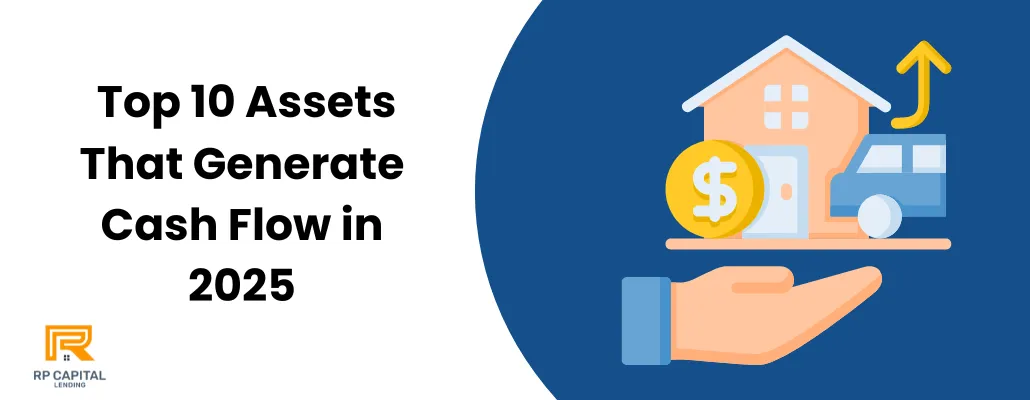Blog

Top 10 Assets That Generate Cash Flow in 2025 (And How to Get Started)
Looking to build wealth that works for you around the clock? You’re not alone. At RP Capital Lending, we talk to investors every day who are ready to stop trading time for money and start building streams of income they can count on.
The great news? There are more ways than ever in 2025 to generate reliable cash flow—whether you want to be hands-on or keep things completely passive. In this guide, we’re breaking down the 10 best cash flow–producing assets you can invest in right now, what makes each one great, and how to know if it’s right for you.
Let’s dive in.
1. 🏘️ Rental Properties: The Tried-and-True Income Engine
Why it works:
Rental properties are the gold standard of cash-flowing assets. When done right, they offer a triple threat: monthly income from tenants, equity growth as your property appreciates, and tax advantages that can significantly boost your bottom line. Over time, your tenants essentially pay down your mortgage while you collect rent—building long-term wealth and generating real cash flow.
Pros:
Monthly Cash Flow: Get paid every month as long as your property is rented—often enough to cover your mortgage and put profit in your pocket.
Appreciation Over Time: Real estate tends to rise in value over the years, especially in growing markets.
Tax Breaks Galore: Mortgage interest, property taxes, depreciation, repairs, even travel to inspect your property—all potentially deductible.
Things to consider:
Upfront Investment: You’ll need a down payment, and possibly extra cash for renovations or maintenance.
Hands-On or Hire Out: Managing tenants, repairs, and turnovers takes time—unless you bring in a property manager.
Who it’s best for:
Ideal for investors seeking reliable, long-term income and asset appreciation. If you’re comfortable with a bit of hands-on work—or can hire someone who is—this is one of the most rewarding wealth-building tools out there.
💡 RP Capital Tip: Not all rental markets are created equal. We help you target high-growth, high-demand areas where rent growth and property values outpace inflation. Want help finding the right investment? That’s exactly what we do.
Read More: The Best Rentometer Alternatives in 2025
2. 🏢 Real Estate Investment Trusts (REITs): Real Estate Without the Wrench
Why it works:
Love the idea of earning income from real estate—but don’t want to deal with tenants, toilets, or turnover? REITs are your best friend. These are companies that own and operate income-producing real estate, and they’re required by law to pay out at least 90% of their profits to shareholders in the form of dividends. And the best part? You can invest in them just like a stock.
Pros:
Easy to Access: Buy and sell REITs through your regular brokerage—no closing costs, inspections, or tenants involved.
Passive Income: REITs pay regular dividends—many on a quarterly basis.
Low Capital Needed: Start investing with as little as $100, sometimes even less with fractional shares.
Things to consider:
Market Tied: REIT prices can fluctuate with the stock market, even if the real estate they own is stable.
No Direct Control: You don’t get to choose which buildings the REIT buys or how it manages them.
Who it’s best for:
REITs are perfect for new investors or anyone wanting exposure to real estate without the management headache. Great for retirement portfolios, too.
3. 💼 Real Estate Debt Funds: Lend Like a Bank, Earn Like an Investor
Why it works:
Think of real estate debt funds as the banking side of real estate. Instead of owning property, you fund the deals. These pooled funds lend money to developers or real estate investors who need short-term capital for projects. In return, you earn steady interest payments—often much higher than what banks offer.
Pros:
Predictable Returns: Annual returns often fall in the 8%–12% range (or more), depending on the fund and the risk level.
Truly Passive: You don’t need to scout deals, underwrite loans, or chase payments. The fund manager handles it all.
Diversified Exposure: Most funds invest in multiple loans, which spreads out your risk.
Things to consider:
Accredited Investor Requirements: Many of these opportunities are only open to investors who meet certain income or net worth thresholds.
Illiquidity: Your money may be locked in for 6–36 months, depending on the fund’s structure.
Who it’s best for:
Perfect for passive investors looking for steady, high-yield income without the hassles of owning property. Especially attractive to those who want diversification outside of the stock market.
💡 RP Capital Insight: At RP Capital Lending, this is our specialty. We help you build a customized debt portfolio that aligns with your income goals and risk tolerance. Whether you're new or experienced, we’ll guide you through every step.
Read More: How To Calculate Cap Rate?
4. 📈 Dividend-Paying Stocks: Cash Flow from Corporate Profits
Why it works:
Dividend-paying stocks allow you to earn regular income just for owning a piece of a company. These stocks distribute a portion of their earnings—typically quarterly—to shareholders. You're not just betting on the stock price going up; you're getting paid to hold on.
Think of it as renting out your money to a successful business—and they pay you in dividends while you potentially enjoy stock appreciation too.
Pros:
Regular Income: Get paid every quarter (or sometimes monthly) without selling your shares.
Growth Potential: Dividend stocks often belong to financially healthy, mature companies that also grow steadily.
Compounding Magic: Reinvest dividends and watch your returns snowball over time.
Things to consider:
Not Immune to Volatility: Even big companies can see stock prices dip during market corrections, which can shake less-seasoned investors.
Not All Dividends Are Equal: Some high yields signal risk—do your research to ensure sustainability.
Who it’s best for:
Investors who want to grow wealth passively while collecting consistent cash payouts—especially ideal for retirement income or long-term portfolios.
5. 🧺 Income-Focused ETFs: Diversified Cash Flow in One Click
Why it works:
Income ETFs (Exchange-Traded Funds) are pre-built portfolios that hold multiple income-generating assets—like dividend stocks, REITs, or bonds. These funds are specifically designed to provide consistent cash flow with less risk, because your money is spread across many companies or securities.
Instead of picking individual winners, you let the ETF do the heavy lifting.
Pros:
Built-in Diversification: One ETF can hold dozens or even hundreds of income-producing investments.
Professionally Managed: Fund managers select and rebalance the assets for you.
Consistent Payouts: Many income ETFs pay monthly or quarterly dividends, creating a predictable income stream.
Things to consider:
Expense Ratios: Management isn’t free. While fees are usually small, they do reduce your net returns.
Yield Can Vary: The income depends on the fund’s holdings—if underlying assets cut dividends, payouts can dip.
Who it’s best for:
Investors who want hands-off, diversified income without needing to research and monitor every individual stock or bond.
Read More: How To Calculate ARV: A Comprehensive Guide
6. 💻 Online Businesses: Digital Real Estate That Pays You
Why it works:
Online businesses—think blogs, YouTube channels, e-commerce stores, and affiliate websites—are the modern version of real estate. You build a valuable digital asset that generates income while you sleep.
Once established, many online businesses run on automated systems for sales, email marketing, or ad revenue.
Pros:
Low Startup Costs: A few hundred dollars can get you started with a website and tools.
Scalable Income: There’s virtually no ceiling—you can grow without adding overhead like a physical store would.
Global Reach: Sell products or ads to customers worldwide, 24/7.
Things to consider:
Initial Learning Curve: You’ll need to learn SEO, content creation, marketing, and tech setup—or outsource it.
Time-Intensive Upfront: The first 6–12 months often require heavy work before the income becomes passive.
Who it’s best for:
Entrepreneurs, creators, or investors willing to build or buy an online income stream that pays over the long term.
7. 🧠 Intellectual Property (IP): Get Paid for What You Create
Why it works:
If you invent, write, design, or create anything original—you might own an asset that can generate royalties. Think music, books, software, patented products, or licensed branding. Once your work is out there, you can get paid again and again for something you created once.
Pros:
Long-Term Passive Income: Royalties from a hit song, bestselling book, or patented tech can pay for years.
Ownership Advantage: You control the rights and terms for how others use your work.
Scalable: IP can be licensed across multiple channels, countries, and industries.
Things to consider:
Slow Ramp-Up: It takes time and marketing to get IP noticed and monetized.
Legal Protection Needed: Proper registration and contracts are critical to protect your rights and income.
Who it’s best for:
Creators, entrepreneurs, or businesses who want to monetize innovation or creativity with long-term recurring income.
8. 🏦 High-Yield Savings Accounts: Safe, Simple Interest
Why it works:
Sometimes boring is beautiful. High-yield savings accounts (HYSAs) are like traditional bank accounts—but with interest rates that are often 10x higher than standard savings accounts.
They're backed by the FDIC (up to $250K), meaning there’s zero risk of losing your money.
Pros:
FDIC Insured: Full protection of your principal.
Liquidity: Access your funds anytime, no penalties.
No Market Exposure: Your balance grows without any volatility.
Things to consider:
Returns Are Modest: Even high-yield accounts can’t match inflation long-term.
Interest Rates Fluctuate: Returns are tied to federal rate changes.
Who it’s best for:
Anyone looking for safe, no-risk returns or a secure place to park emergency funds while still earning something.
9. 📃 Certificates of Deposit (CDs): Locked-In Income with a Guarantee
Why it works:
CDs are time-locked deposits with banks or credit unions that pay a guaranteed interest rate for the duration—often 6 months to 5 years. They're a favorite for low-risk investors who want certainty over performance.
Pros:
FDIC Insured: Safe as savings accounts.
Predictable Returns: Know exactly what you’ll earn over the term.
Good for Planning: Ideal for short-term savings goals (e.g., car, wedding, down payment).
Things to consider:
Early Withdrawal Penalties: You can’t access your money without a fee unless you wait until maturity.
Inflation Risk: Low rates mean your purchasing power may erode over time.
Who it’s best for:
Investors seeking risk-free, guaranteed income with a clear timeline for use of funds.
Read More: What Is Table Funding? Definition, Benefits, and How It Works
10. 👥 Peer-to-Peer Lending: Be the Bank, Earn the Interest
Why it works:
Peer-to-peer (P2P) platforms connect borrowers with individual investors—cutting out traditional banks. You lend money to vetted borrowers and earn interest, often higher than savings or CDs.
Pros:
Attractive Yields: Annual returns of 6–10% are common with the right platform.
Low Entry Point: You can start with as little as $25 per loan.
Automated Options: Most platforms offer tools to auto-invest based on your preferences.
Things to consider:
Borrower Default Risk: Some loans may go unpaid; platforms rank borrowers by risk level.
Limited Liquidity: You may have to wait months or years for full repayment.
Who it’s best for:
Investors comfortable with some risk in exchange for higher passive income—especially those looking to diversify beyond traditional stocks and bonds.
🚀 Final Thoughts: Build Your Cash Flow Your Way
There’s no one-size-fits-all approach when it comes to generating income. Whether you're stacking rental properties or building a portfolio of dividend stocks and lending notes, the key is this:
✅ Start where you are
✅ Diversify as you grow
✅ Choose assets that match your goals and comfort level
At RP Capital Lending, we specialize in helping investors find secure, high-yield lending opportunities—whether you're looking to invest passively or build a real estate empire.
Ready to build income that doesn’t sleep? Let’s talk.
Top 5 FAQs on Cash-Flowing Assets
1. What is the best asset to generate passive income?
It depends on your goals, but rental properties, dividend stocks, and real estate debt funds are among the top options for reliable cash flow.
2. How much money do I need to start investing in cash-flowing assets?
You can start with as little as $100 in REITs, ETFs, or high-yield savings accounts. Real estate typically requires more capital upfront.
3. Are all cash-flow assets truly passive?
Not all. Some, like rental properties or online businesses, require management unless outsourced. Others, like ETFs or debt funds, are fully passive.
4. Which cash-flow assets are the safest?
High-yield savings accounts, CDs, and certain REITs offer low risk but also lower returns. Always match safety with your income goals.
5. Can I mix different assets to generate cash flow?
Absolutely. A diversified approach spreads risk and can increase total income. Many investors blend real estate, stocks, and debt-based assets.
RP Capital Lending is a d.b.a of RP Capital Partners Inc (NMLS # 2469193) | Privacy Policy
Copyright © 2022. All Rights Reserved.
Disclaimer: Loans only apply to non-owner occupied properties. Rates, terms and conditions offered only to qualified borrowers, may vary upon loan product, deal structure, other applicable considerations, and are subject to change at any time without notice.

